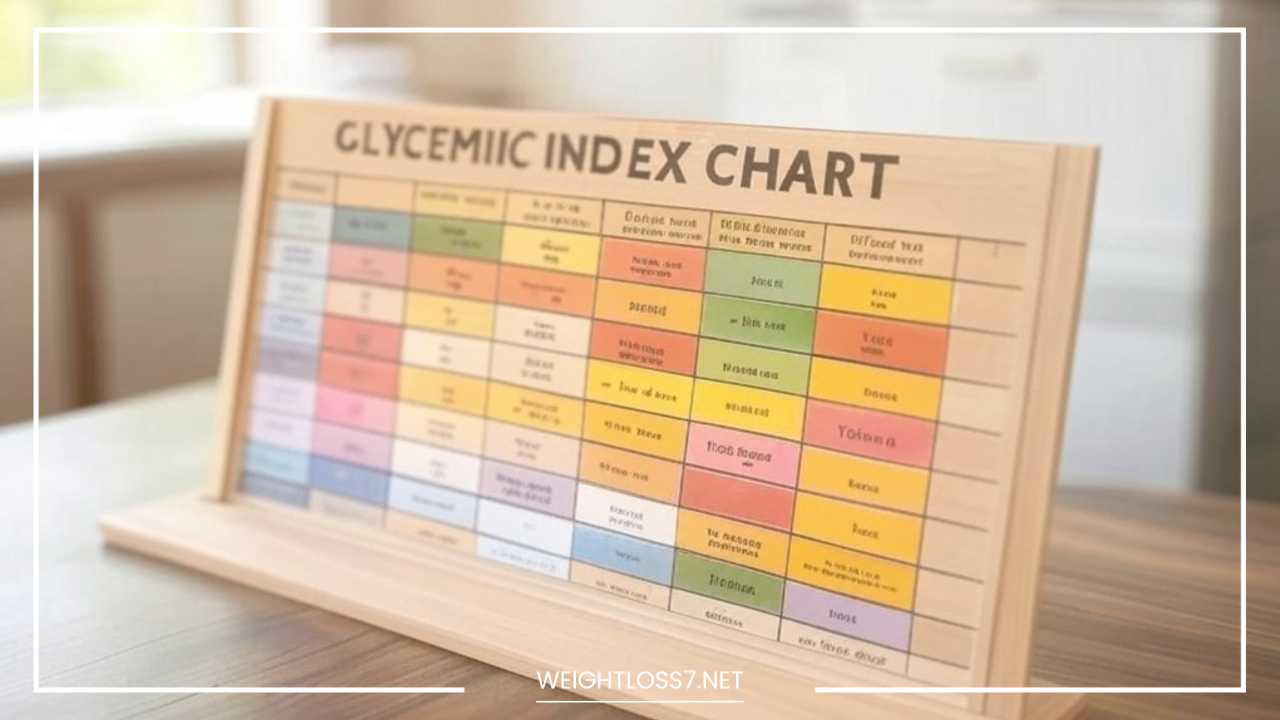What is Glycemic Index

Glycemic Index
What is the Glycemic Index? A Comprehensive Guide
The glycemic index (GI) is a system used to measure how carbohydrate-containing foods affect blood glucose levels.
It provides valuable information about how quickly and to what extent the carbohydrates in food are converted into glucose (sugar) in the bloodstream.
Understanding the glycemic index can help you make healthier food choices, manage your weight, stabilize your energy levels, and improve overall health.
The concept of the glycemic index was introduced in the early 1980s by Dr. David Jenkins and his team at the University of Toronto.
Their goal was to create a standardized way to measure how different foods impact blood sugar levels, and how that, in turn, affects insulin and overall metabolism.
The glycemic index has become a powerful tool for managing conditions such as diabetes, insulin resistance, and obesity, while also promoting heart health and energy balance.
How is the Glycemic Index Calculated?
To calculate the GI of a specific food, researchers conduct a series of tests involving a group of healthy individuals.
Each participant consumes a portion of the food that contains 50 grams of digestible carbohydrates. Their blood glucose levels are then measured over a two-hour period following consumption.
This blood glucose response is compared to the response after consuming 50 grams of pure glucose, which is considered the reference food with a GI value of 100.
The GI of the test food is calculated as the area under the blood glucose curve for that food, as a percentage of the blood glucose response to the reference food (glucose).
Understanding GI Values
The glycemic index categorizes foods into three main groups based on their effect on blood sugar levels:
- Low GI: Foods with a GI of 55 or less. These foods cause a slow, gradual rise in blood sugar levels and are usually rich in fiber, fat, or protein, which slow down digestion.
- Medium GI: Foods with a GI between 56 and 69. These foods cause a moderate rise in blood sugar levels and are generally considered to be a balanced source of carbohydrates.
- High GI: Foods with a GI of 70 or more. These foods cause a rapid spike in blood sugar levels, as they are quickly broken down and absorbed into the bloodstream.
Understanding these values allows individuals to make informed choices about which foods will have the least disruptive effect on their blood sugar levels, ultimately supporting better metabolic health.
What is a High Glycemic Index?
High GI foods are characterized by a rapid digestion and absorption process that leads to a quick increase in blood glucose levels.
These foods are often highly processed or refined, which strips them of fiber and other nutrients that help slow down digestion.
A rapid spike in blood sugar can trigger a surge in insulin levels, which may lead to a subsequent drop in blood sugar, causing feelings of fatigue, hunger, or cravings.
Common examples of high GI foods include:
- White bread: Made from refined wheat flour, white bread is quickly digested, leading to a sharp increase in blood sugar levels.
- White rice: Like white bread, white rice has been stripped of its fiber content, causing it to have a high glycemic index.
- Potatoes: Potatoes, especially when baked or mashed, have a high glycemic index due to their high starch content.
- Sugary drinks: Sodas, fruit juices, and energy drinks contain added sugars that are quickly absorbed into the bloodstream, causing a sharp rise in glucose levels.
- Processed snacks and candy: These foods are often loaded with refined sugars, flour, and unhealthy fats, making them quick sources of glucose.
Low Glycemic Index Foods
Low GI foods, on the other hand, are digested more slowly, resulting in a gradual increase in blood glucose levels. These foods are typically high in fiber, fat, or protein, which help slow down the digestion process.
The slow release of glucose into the bloodstream helps maintain stable energy levels and supports better blood sugar control.
Examples of low GI foods include:
- Whole grains: Whole wheat bread, quinoa, oats, barley, and brown rice are all rich in fiber, which helps lower their glycemic impact.
- Legumes: Beans, lentils, chickpeas, and peas are excellent sources of both fiber and protein, which help slow digestion.
- Fruits: Most fruits, such as apples, pears, berries, and cherries, have a low GI. However, some fruits, such as watermelon and ripe bananas, have a higher GI due to their sugar content and ripeness.
- Vegetables: Most non-starchy vegetables, like leafy greens, carrots, cucumbers, and bell peppers, have a low glycemic index.
- Nuts and seeds: Almonds, walnuts, chia seeds, and flaxseeds are high in healthy fats and fiber, making them ideal for stabilizing blood sugar.
Incorporating more low GI foods into your diet can help maintain stable energy levels and may be beneficial for managing conditions such as diabetes and obesity.
Factors Affecting the Glycemic Index
Several factors can influence the glycemic index of a particular food, including:
- Ripeness of fruits: As fruits ripen, their sugar content increases, which can raise their glycemic index. For example, a ripe banana has a higher GI than an unripe one.
- Cooking methods: The way a food is cooked can affect its glycemic index. For example, boiled potatoes have a lower GI than baked potatoes, and al dente pasta has a lower GI than overcooked pasta.
- Processing: Highly processed foods tend to have a higher glycemic index because they are stripped of fiber and nutrients. Whole foods, on the other hand, tend to have a lower GI.
- Fiber content: Foods that are high in fiber, such as vegetables, fruits, legumes, and whole grains, tend to have a lower GI because fiber slows digestion and absorption.
- Fat and protein content: Foods containing fat and protein tend to have a lower GI because they slow down the rate at which carbohydrates are digested and absorbed.
- Food combinations: Pairing high GI foods with low GI foods, or with foods that contain fat or protein, can help to reduce the overall glycemic impact of a meal. For example, combining a high GI food like white bread with a source of protein, such as cheese or chicken, can lower the GI of the entire meal.
Benefits of a Low Glycemic Diet
A low GI diet has been associated with several health benefits, including:
1. Improved Blood Sugar Control
A low GI diet helps regulate blood sugar levels by promoting a gradual release of glucose into the bloodstream.
This is especially beneficial for individuals with diabetes or insulin resistance. By preventing large blood sugar spikes and crashes, a low GI diet can help stabilize blood sugar levels and reduce the need for large amounts of insulin.
This can make it easier to manage diabetes and prevent complications related to poor blood sugar control, such as neuropathy, heart disease, and kidney damage.
2. Weight Management
Low GI foods are typically more satiating than high GI foods, helping to control hunger and reduce overeating.
Foods that cause slow, steady increases in blood sugar also tend to provide longer-lasting energy, which helps to prevent energy crashes and cravings.
A diet rich in low GI foods can promote feelings of fullness and satisfaction, making it easier to maintain or lose weight. Additionally, low GI foods are often lower in calories and contain more fiber, which further aids in weight management.
3. Reduced Risk of Chronic Diseases
Research has shown that a low GI diet may reduce the risk of developing chronic diseases, including:
- Heart disease: A low GI diet helps to improve blood lipid profiles by lowering levels of triglycerides and LDL (bad) cholesterol, both of which are risk factors for heart disease.
- Type 2 diabetes: By stabilizing blood sugar and insulin levels, a low GI diet can reduce the risk of developing type 2 diabetes. It is also beneficial for those already managing diabetes.
- Cancer: Some studies suggest that a low GI diet may lower the risk of certain cancers, particularly those of the colon, breast, and prostate.
4. Increased Energy and Enhanced Mood
By preventing blood sugar fluctuations, a low GI diet can lead to more consistent energy levels throughout the day.
Instead of experiencing energy crashes and fatigue after consuming high GI foods, individuals following a low GI diet may feel more energetic and focused.
Additionally, stable blood sugar levels have been linked to improved mood and reduced symptoms of anxiety and depression.
Does Blending Fruit Increase the Glycemic Index?
Blending fruit has become a popular trend, particularly with the rise of smoothies. However, there is some debate over whether blending fruit increases its glycemic index.
Some studies suggest that blending fruit may raise the GI, while others indicate no significant change, or even a decrease in the GI. The impact of blending depends on several factors:
- Type of fruit: Some fruits, such as berries, may release more fiber when blended, potentially lowering the GI. On the other hand, fruits with high sugar content, such as ripe bananas or watermelon, may see an increase in GI when blended.
- Blending method: The extent to which fruit is blended can also influence its GI. Over-blending can break down the fiber and release sugars more quickly, potentially raising the GI. Less blending, which retains more of the fruit’s structure, may preserve the fiber and result in a lower GI.
- Combination with other foods: Adding protein, fat, or fiber-rich foods (such as yogurt, avocado, or seeds) to a fruit smoothie can help lower the overall glycemic response.
While more research is needed to fully understand the impact of blending on the glycemic index, it’s clear that fruit smoothies made from whole, unprocessed ingredients and paired with healthy fats or proteins are likely to have a more balanced effect on blood sugar levels.
Incorporating the Glycemic Index into Your Diet
Understanding the glycemic index can help you make healthier food choices and improve your overall diet. Here are some practical tips for incorporating the GI into your everyday meals:
1. Prioritize Low GI Foods
When planning meals, focus on foods that are naturally low in GI, such as whole grains, legumes, fruits, vegetables, nuts, and seeds.
These foods not only help maintain steady blood sugar levels but also provide a wide range of essential nutrients, including fiber, vitamins, minerals, and antioxidants.
2. Limit High GI Foods
While it’s okay to enjoy high GI foods occasionally, try to minimize your intake of refined grains, sugary snacks, and processed foods.
These foods can cause rapid blood sugar spikes, which may lead to long-term health issues such as insulin resistance, weight gain, and increased risk of chronic diseases.
3. Combine Foods Wisely
Pair high GI foods with low GI foods to help reduce the glycemic impact of a meal. For example, add a serving of vegetables or a source of protein, such as chicken or beans, to a meal with white rice or bread.
This combination can slow down the digestion of carbohydrates and prevent large blood sugar fluctuations.
4. Be Mindful of Portion Sizes
Even with low GI foods, portion size matters. Eating large portions of low GI foods can still lead to an excessive calorie intake and potential blood sugar fluctuations.
Be mindful of portion sizes, especially when consuming carbohydrate-rich foods, to maintain a healthy balance.
5. Listen to Your Body
Everyone’s body reacts differently to certain foods. Pay attention to how different foods make you feel in terms of energy, hunger, and mood.
Experiment with your meals and monitor how various foods affect your blood sugar and overall well-being. This will help you make personalized adjustments to your diet.
Final Thoughts
The glycemic index is a useful tool for understanding how carbohydrates affect blood sugar levels. By choosing low GI foods, pairing them wisely with other foods, and being mindful of portion sizes, you can improve blood sugar control, manage your weight, and reduce the risk of chronic diseases.
While the impact of blending fruit on GI remains a topic of ongoing research, understanding the GI of different foods can help you make healthier choices for long-term health and well-being.
Note: This article provides general information about the glycemic index and should not be considered medical advice. For personalized dietary recommendations, consult with a healthcare professional or registered dietitian.

















